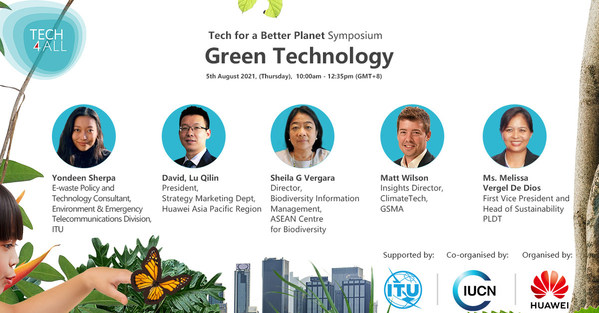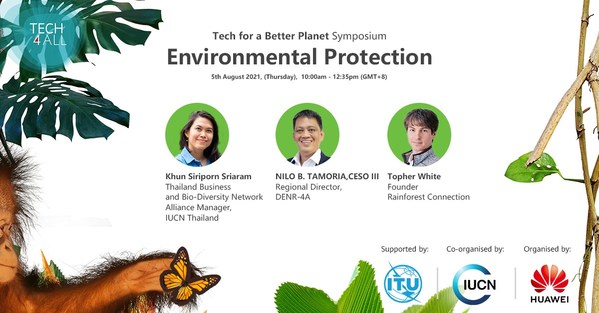KUALA LUMPUR, Malaysia, Aug. 9, 2021 /PRNewswire/ — Working with cross-sector partners, Huawei vows to enable the green transformation and supports on carbon emission cutting to tackle climate issues in the Asia Pacific region, Kevin Zhang Huawei’s Chief Marketing Officer of ICT infrastructure said at the Tech for a Better Planet Webinar on Thursday.

Climate change presents a key challenge for social development, driving an urgent need for a low-carbon society & green growth models to protect the environment & promote green economic recovery.
The webinar, co-organized by IUCN (International Union for Conservation of Nature) and Huawei, and supported by ITU (International Telecommunication Union), brought together industrial experts and opinion leaders from the ICT and environmental protection communities across the Asia Pacific region. This two-part webinar series explored how technology can drive environmental protection and ensure sustainable development in Asia Pacific.
“Now more than ever, we need to re-assess our relationship with nature and move faster towards nature-positive and low-carbon growth models. We believe that technology is a key part of the solution,” said Kevin Zhang, CMO of Huawei ICT infrastructure.
Panelists at the “Green Technology” session of the webinar emphasized that technology can work in harmony with nature and help Asia Pacific nations to accomplish green transformation, especially for the economic recovery in the post pandemic era.
“ICT has become central to conversations around environmental sustainability,” said Yondeen Sherpa, E-waste Policy and Technology Consultant at the Environment & Emergency Telecommunications Division of the International Telecommunication Union (ITU). To contribute to the pursuit of the SDGs, ITU is working together with members like Huawei to develop international standards and provided measurement methodologies addressing ICT, environment, and circular economy.
E-waste, as one of the fastest growing and most complex waste streams in the world, is affecting both human health and the environment, and proliferating a loss of valuable raw materials. At the same time, if treated through appropriate recycling methods, e-waste could offer economic returns worth, valuable raw materials and new jobs in recycling, Sherpa explained.
As part of the efforts to recycle as much electronic waste as possible, Huawei has built a global recycling program for device products and scaled up the product trade-in program. Over the course of 2020, Huawei processed more than 4,500 tons of e-waste through its recycling stations.
Experts at the webinar agreed that energy will be the foundation of the digital world. To help create a low-carbon world, ICT industry should take more efforts on cutting carbon emissions, promoting renewable energy, and contributing to a circular economy.
“The future for global energy will be low-carbon, electrical, and digital. Using technologies to efficiently convert, store, and control electric energy and continuously improve digitalization level is an important way to help create a low-carbon world. From the perspective of the ICT industry, Huawei has been committed to using less energy to transmit, process and store more information. Taking 5G as an example, the energy consumption per bit is only about one tenth of 4G. This is a big achievement,” said David Lu, President at the Strategic Marketing Dept of Huawei Asia Pacific.
Huawei has deployed its digital power solutions in more than 170 countries and regions. To date, these solutions have generated 325 billion kWh of electricity from renewable sources and saved 10 billion kWh of electricity.
“In Asia Pacific, we completed multiple intelligent photovoltaic projects and provided a total of 18 GigaWatt inverters for these projects and contributed to the successful grid connection, which was equivalent to reducing CO2 emissions more than 12.8 million tons,” David Lu added.
In Singapore, for example, Huawei FusionSolar Solution has supported Sunseap Group, a solar energy solutions provider, to build one of world’s largest offshore floating Photovoltaic (PV) farms. With 13,312 solar panels, 40 inverters, and more than 30,000 floats, this five-hectare sea-based solar plant is estimated to produce up to 6,022,500 kWh of energy per year, supplying enough power for 1250 four-room public housing flats on the island and offsetting an estimated amount of 4258 tons of carbon dioxide.
“Advances in technology can help us better understand and protect nature and reduce the impact of human activity on the planet. It can also help the ICT industry and other sectors move to low carbon models that use less energy to transmit, process, and store data. At the same time, it can make energy systems more efficient,” said Kevin Zhang, CMO of Huawei ICT infrastructure.

Climate change presents a key challenge for social development, driving an urgent need for a low-carbon society & green growth models to protect the environment & promote green economic recovery.










